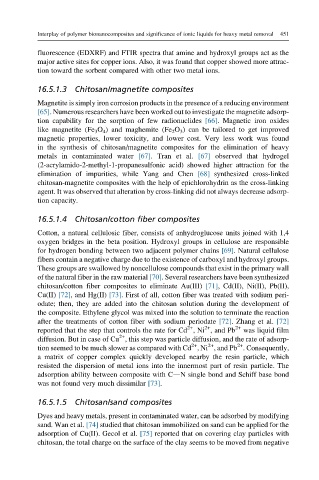Page 498 - Polymer-based Nanocomposites for Energy and Environmental Applications
P. 498
Interplay of polymer bionanocomposites and significance of ionic liquids for heavy metal removal 451
fluorescence (EDXRF) and FTIR spectra that amine and hydroxyl groups act as the
major active sites for copper ions. Also, it was found that copper showed more attrac-
tion toward the sorbent compared with other two metal ions.
16.5.1.3 Chitosan/magnetite composites
Magnetite is simply iron corrosion products in the presence of a reducing environment
[65]. Numerous researchers have been worked out to investigate the magnetite adsorp-
tion capability for the sorption of few radionuclides [66]. Magnetic iron oxides
like magnetite (Fe 3 O 4 ) and maghemite (Fe 2 O 3 ) can be tailored to get improved
magnetic properties, lower toxicity, and lower cost. Very less work was found
in the synthesis of chitosan/magnetite composites for the elimination of heavy
metals in contaminated water [67]. Tran et al. [67] observed that hydrogel
(2-acrylamido-2-methyl-1-propanesulfonic acid) showed higher attraction for the
elimination of impurities, while Yang and Chen [68] synthesized cross-linked
chitosan-magnetite composites with the help of epichlorohydrin as the cross-linking
agent. It was observed that alteration by cross-linking did not always decrease adsorp-
tion capacity.
16.5.1.4 Chitosan/cotton fiber composites
Cotton, a natural cellulosic fiber, consists of anhydroglucose units joined with 1,4
oxygen bridges in the beta position. Hydroxyl groups in cellulose are responsible
for hydrogen bonding between two adjacent polymer chains [69]. Natural cellulose
fibers contain a negative charge due to the existence of carboxyl and hydroxyl groups.
These groups are swallowed by noncellulose compounds that exist in the primary wall
of the natural fiber in the raw material [70]. Several researchers have been synthesized
chitosan/cotton fiber composites to eliminate Au(III) [71], Cd(II), Ni(II), Pb(II),
Cu(II) [72], and Hg(II) [73]. First of all, cotton fiber was treated with sodium peri-
odate; then, they are added into the chitosan solution during the development of
the composite. Ethylene glycol was mixed into the solution to terminate the reaction
after the treatments of cotton fiber with sodium periodate [72]. Zhang et al. [72]
2+
2+
reported that the step that controls the rate for Cd ,Ni , and Pb 2+ was liquid film
2+
diffusion. But in case of Cu , this step was particle diffusion, and the rate of adsorp-
2+
2+
2+
tion seemed to be much slower as compared with Cd ,Ni , and Pb . Consequently,
a matrix of copper complex quickly developed nearby the resin particle, which
resisted the dispersion of metal ions into the innermost part of resin particle. The
adsorption ability between composite with CdN single bond and Schiff base bond
was not found very much dissimilar [73].
16.5.1.5 Chitosan/sand composites
Dyes and heavy metals, present in contaminated water, can be adsorbed by modifying
sand. Wan et al. [74] studied that chitosan immobilized on sand can be applied for the
adsorption of Cu(II). Gecol et al. [75] reported that on covering clay particles with
chitosan, the total charge on the surface of the clay seems to be moved from negative

